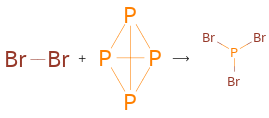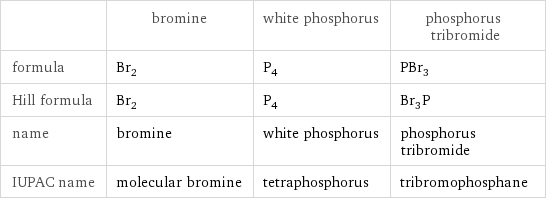Input interpretation

Br_2 bromine + P_4 white phosphorus ⟶ PBr_3 phosphorus tribromide
Balanced equation

Balance the chemical equation algebraically: Br_2 + P_4 ⟶ PBr_3 Add stoichiometric coefficients, c_i, to the reactants and products: c_1 Br_2 + c_2 P_4 ⟶ c_3 PBr_3 Set the number of atoms in the reactants equal to the number of atoms in the products for Br and P: Br: | 2 c_1 = 3 c_3 P: | 4 c_2 = c_3 Since the coefficients are relative quantities and underdetermined, choose a coefficient to set arbitrarily. To keep the coefficients small, the arbitrary value is ordinarily one. For instance, set c_2 = 1 and solve the system of equations for the remaining coefficients: c_1 = 6 c_2 = 1 c_3 = 4 Substitute the coefficients into the chemical reaction to obtain the balanced equation: Answer: | | 6 Br_2 + P_4 ⟶ 4 PBr_3
Structures

+ ⟶
Names

bromine + white phosphorus ⟶ phosphorus tribromide
Equilibrium constant
![Construct the equilibrium constant, K, expression for: Br_2 + P_4 ⟶ PBr_3 Plan: • Balance the chemical equation. • Determine the stoichiometric numbers. • Assemble the activity expression for each chemical species. • Use the activity expressions to build the equilibrium constant expression. Write the balanced chemical equation: 6 Br_2 + P_4 ⟶ 4 PBr_3 Assign stoichiometric numbers, ν_i, using the stoichiometric coefficients, c_i, from the balanced chemical equation in the following manner: ν_i = -c_i for reactants and ν_i = c_i for products: chemical species | c_i | ν_i Br_2 | 6 | -6 P_4 | 1 | -1 PBr_3 | 4 | 4 Assemble the activity expressions accounting for the state of matter and ν_i: chemical species | c_i | ν_i | activity expression Br_2 | 6 | -6 | ([Br2])^(-6) P_4 | 1 | -1 | ([P4])^(-1) PBr_3 | 4 | 4 | ([PBr3])^4 The equilibrium constant symbol in the concentration basis is: K_c Mulitply the activity expressions to arrive at the K_c expression: Answer: | | K_c = ([Br2])^(-6) ([P4])^(-1) ([PBr3])^4 = ([PBr3])^4/(([Br2])^6 [P4])](../image_source/f71e21429df40dd62f44f816156fe3d6.png)
Construct the equilibrium constant, K, expression for: Br_2 + P_4 ⟶ PBr_3 Plan: • Balance the chemical equation. • Determine the stoichiometric numbers. • Assemble the activity expression for each chemical species. • Use the activity expressions to build the equilibrium constant expression. Write the balanced chemical equation: 6 Br_2 + P_4 ⟶ 4 PBr_3 Assign stoichiometric numbers, ν_i, using the stoichiometric coefficients, c_i, from the balanced chemical equation in the following manner: ν_i = -c_i for reactants and ν_i = c_i for products: chemical species | c_i | ν_i Br_2 | 6 | -6 P_4 | 1 | -1 PBr_3 | 4 | 4 Assemble the activity expressions accounting for the state of matter and ν_i: chemical species | c_i | ν_i | activity expression Br_2 | 6 | -6 | ([Br2])^(-6) P_4 | 1 | -1 | ([P4])^(-1) PBr_3 | 4 | 4 | ([PBr3])^4 The equilibrium constant symbol in the concentration basis is: K_c Mulitply the activity expressions to arrive at the K_c expression: Answer: | | K_c = ([Br2])^(-6) ([P4])^(-1) ([PBr3])^4 = ([PBr3])^4/(([Br2])^6 [P4])
Rate of reaction
![Construct the rate of reaction expression for: Br_2 + P_4 ⟶ PBr_3 Plan: • Balance the chemical equation. • Determine the stoichiometric numbers. • Assemble the rate term for each chemical species. • Write the rate of reaction expression. Write the balanced chemical equation: 6 Br_2 + P_4 ⟶ 4 PBr_3 Assign stoichiometric numbers, ν_i, using the stoichiometric coefficients, c_i, from the balanced chemical equation in the following manner: ν_i = -c_i for reactants and ν_i = c_i for products: chemical species | c_i | ν_i Br_2 | 6 | -6 P_4 | 1 | -1 PBr_3 | 4 | 4 The rate term for each chemical species, B_i, is 1/ν_i(Δ[B_i])/(Δt) where [B_i] is the amount concentration and t is time: chemical species | c_i | ν_i | rate term Br_2 | 6 | -6 | -1/6 (Δ[Br2])/(Δt) P_4 | 1 | -1 | -(Δ[P4])/(Δt) PBr_3 | 4 | 4 | 1/4 (Δ[PBr3])/(Δt) (for infinitesimal rate of change, replace Δ with d) Set the rate terms equal to each other to arrive at the rate expression: Answer: | | rate = -1/6 (Δ[Br2])/(Δt) = -(Δ[P4])/(Δt) = 1/4 (Δ[PBr3])/(Δt) (assuming constant volume and no accumulation of intermediates or side products)](../image_source/015629af7e5cc755f8e4d78a5e9cb42f.png)
Construct the rate of reaction expression for: Br_2 + P_4 ⟶ PBr_3 Plan: • Balance the chemical equation. • Determine the stoichiometric numbers. • Assemble the rate term for each chemical species. • Write the rate of reaction expression. Write the balanced chemical equation: 6 Br_2 + P_4 ⟶ 4 PBr_3 Assign stoichiometric numbers, ν_i, using the stoichiometric coefficients, c_i, from the balanced chemical equation in the following manner: ν_i = -c_i for reactants and ν_i = c_i for products: chemical species | c_i | ν_i Br_2 | 6 | -6 P_4 | 1 | -1 PBr_3 | 4 | 4 The rate term for each chemical species, B_i, is 1/ν_i(Δ[B_i])/(Δt) where [B_i] is the amount concentration and t is time: chemical species | c_i | ν_i | rate term Br_2 | 6 | -6 | -1/6 (Δ[Br2])/(Δt) P_4 | 1 | -1 | -(Δ[P4])/(Δt) PBr_3 | 4 | 4 | 1/4 (Δ[PBr3])/(Δt) (for infinitesimal rate of change, replace Δ with d) Set the rate terms equal to each other to arrive at the rate expression: Answer: | | rate = -1/6 (Δ[Br2])/(Δt) = -(Δ[P4])/(Δt) = 1/4 (Δ[PBr3])/(Δt) (assuming constant volume and no accumulation of intermediates or side products)
Chemical names and formulas

| bromine | white phosphorus | phosphorus tribromide formula | Br_2 | P_4 | PBr_3 Hill formula | Br_2 | P_4 | Br_3P name | bromine | white phosphorus | phosphorus tribromide IUPAC name | molecular bromine | tetraphosphorus | tribromophosphane
Substance properties

| bromine | white phosphorus | phosphorus tribromide molar mass | 159.81 g/mol | 123.89504799 g/mol | 270.69 g/mol phase | liquid (at STP) | solid (at STP) | liquid (at STP) melting point | -7.2 °C | 44.15 °C | -41.5 °C boiling point | 58.8 °C | 280.5 °C | 175 °C density | 3.119 g/cm^3 | 1.823 g/cm^3 | 2.88 g/cm^3 solubility in water | insoluble | insoluble | reacts surface tension | 0.0409 N/m | | 0.0458 N/m dynamic viscosity | 9.44×10^-4 Pa s (at 25 °C) | 0.00169 Pa s (at 50 °C) | 0.001302 Pa s (at 60 °C) odor | | odorless |
Units
